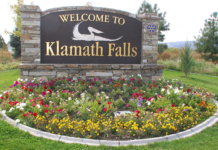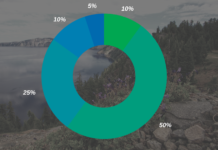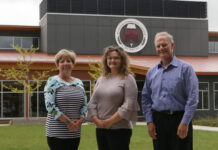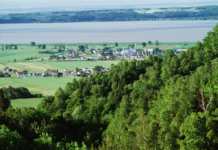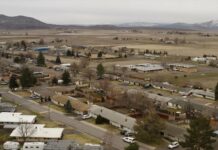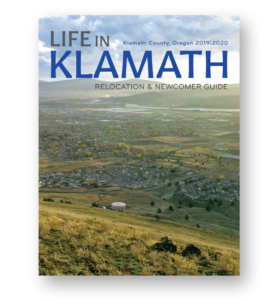The Klamath Basin was hit particularly hard during the 2008 recession, and it has taken many years to return to the economic prosperity felt before the downturn, but economic experts in Klamath County agree that the business climate is now on the upswing.
“I think we are fully out of the 2008 recession,” said Heather Tramp, Executive Director of the Klamath County Chamber of Commerce. “Every year I conduct a business survey, comparing this year to last year. For the last two years the surveys were very positive, people felt like business was good, money was being spent locally, and business owners had opportunity to grow.”
There are, of course, many factors to be considered in making such a superlative judgment of the economic health of the region. Increasing sales figures, relatively low unemployment figures compared to a decade ago, and reinvestment in the community all stand as measurable indicators that prospects at this juncture are positive.
Tramp noted that she has seen an increase in community sponsorships, donations and volunteerism – all additional equitable markers of a prosperous economic environment. “Business is going well enough that now they are giving back,” added Tramp. “People are feeling like they can give back in charitable ways and volunteer. We look at progress in our community like new parks being built, and people attending more public events.”
“I believe we are the best county in the best state in the union, I love Oregon, and I believe we’re in the best part of it.”
The Chamber of Commerce isn’t alone in noticing an uptick in Klamath Basin prospects. Kat Rutledge, Director of the Klamath Community College (KCC) Small Business Development Center (SBDC), noted that entrepreneurs seeking SBDC guidance have recently grown – an indicator of new businesses opening and established companies looking to expand. In 2018 the SBDC served a total of 141 businesses in advising, whereas in just the first quarter of 2019 alone 75 businesses were aided through their services. Rutledge sees a trend of reinvestment by downtown businesses to upgrade facilities and pursue matching grants through the Klamath Falls Downtown Association (KFDA). She also noted that bankers, with whom she stays in contact to gauge business loan requests, have seen an increase in people who want to purchase property or invest locally.
“The indicator that I think is exciting is that we’re starting to see a slow, but steady increase in non-farm proprietor income,” said Rutledge. “What is notable about that is these are our locally-owned main street-type businesses in Klamath County, and when they prosper they hire more employees, increase wages, pay more taxes, and are free to be more actively involved in their communities.”
To help spur economic tides a variety of organizations including SBDC and the Chamber of Commerce have partnered in what is known as the Klamath IDEA (Inspire Development Energize Acceleration) – a community initiative committed to creating a thriving entrepreneurial ecosystem to increase opportunities for wealth and prosperity in southcentral Oregon. Through support services, referrals, advisement, networking events and more; an abundance of support exists to help business grow locally – an effort which they consider to be a “team sport.”
“One of the keys to economic renewal is attracting and retaining people,” added Rutledge. “A growing population contributes to schools, workforce, healthcare, arts, culture, and business. However, rapid growth isn’t necessary and I’m glad to say our population is now trending in the right direction, albeit slowly.”

According to the U.S. Census Bureau, Klamath County population continues to increase, from 66,380 in 2010 to 67,596 in 2017, and by 2022 population is expected to grow to 68,400 Beyond the numbers, there are intangibles to the Klamath Basin that are enticing for prospective business owners, or those simply seeking a change in lifestyle. An abundance of outdoor activities surrounds the Klamath region, short commutes with little traffic are a big relief from larger cities, intersecting railroads and highways fuel commerce, and a quality of life comparative to major metropolitan areas are enticing.
“We have a lot of amenities – nice theaters, nice arts and culture typically found in bigger cities, but I can go five minutes and be hiking in the woods in solitude,” said Tramp. “There are a lot of buildings and properties available, and for larger companies because of the relatively small size of our community they can be creative with offered incentives. Cost of living can’t be forgotten, and we are centrally located being five hours from Reno, San Francisco and Portland.” “The rural lifestyle, the pace, the quality of life – all of that is becoming exceedingly intriguing and popular among the under-40 crowd,” added Rutledge. “It is the cost of living, the pace of life – but one thing communities must have to be attractive is broadband, particularly since millennials are incredibly mobile these days. They are the largest generation in the workforce currently, and people love the idea of working when and where they want and when done they can go hike, bike, and kayak. That is a tremendous asset we have in our community.”
An additional attraction offered statewide across Oregon is the lack of a sales tax.
“I believe we are the best county in the best state in the union,” said Tramp. “I love Oregon, and I believe we’re in the best part of it. There is so much opportunity here. There are needs in our community, but if you have the ability to fill one of those needs then the opportunity is endless and someone could create their own success very easily. We also have a great workforce, there are qualified and talented people here because of Oregon Tech and Klamath Community College, and the work ethic is strong.”
An area once largely dependent on the timber industry, the Klamath Basin has undergone a big transition from an area once dominated primarily by lumber mills to a versatile and industrious region. Economic downfalls may come and go with the ebb and tides of national trends, but the fortified infrastructure behind the Klamath Basin’s economic prosperity remains strong into the future



